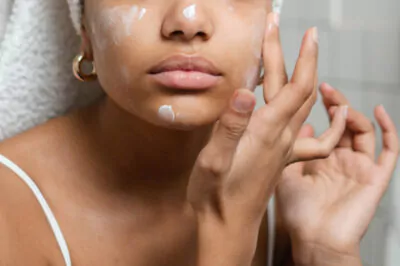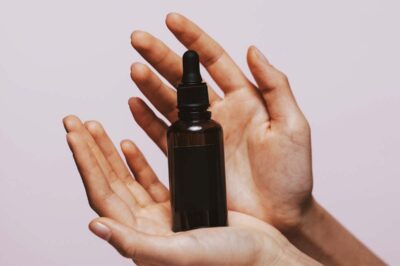Table of Contents[Hide][Show]
Vitamin C serum: a celebrated skin care “star” globally loved for brightening and improving the appearance of aging skin. Yet, some users face a common minor issue: Vitamin C serum skin stains. But don’t worry, Vitamin C serum stains are normal and manageable!
Before we dive into solutions, consider these key points:
- It’s not your skin’s fault: Vitamin C staining is a common occurrence, not a sign your skin is “reacting badly.”
- Prevention is absolutely possible: With the right knowledge and techniques, you can use Vitamin C serum stain-free.
- Stain removal is simple: Even if stains appear, you can easily and quickly get rid of them.
This article will “decode” everything about Vitamin C serum stains: from the root cause (oxidation mechanism), effective stain removal (exfoliation), to prevention secrets (stable serums, proper use), and how to spot an oxidized serum. Armed with this knowledge, you can confidently master Vitamin C serum, enjoying radiant skin without stain worries!
Why Does Vitamin C Serum Stain Skin? (Oxidation Mechanism)
The main culprit behind Vitamin C serum skin stains, in reality, is oxidation. Understanding this mechanism is key to effectively managing skin staining.
L-Ascorbic Acid (or ascorbic acid) is a common Vitamin C choice in skin care due to its many skin care benefits. First, it’s renowned for its potent antioxidant capabilities, protecting skin from environmental stressors. Additionally, L-Ascorbic Acid is known for its ability to brighten skin and enhance the appearance of youthful skin. However, despite these benefits, L-Ascorbic Acid, unlike different types of vitamin C, has a notable drawback—its inherent instability. This Vitamin C form is highly prone to oxidation when exposed to air, light, or water. This very characteristic of instability, combined with oxidation, makes L-Ascorbic Acid the main cause of skin staining with Vitamin C serums.
When L-Ascorbic Acid encounters air, light, or water, the oxidation process unfolds in steps:
- Oxidation of L-Ascorbic Acid: L-Ascorbic Acid molecules begin to oxidize, a natural chemical reaction altering their structure and properties.
- Erythrulose Formation: This oxidation process transforms the Vitamin C into a new substance: erythrulose.
- Erythrulose Causes Skin Stain: Interestingly, erythrulose is the primary active ingredient in self-tanning products. Similar to how self-tanners create a tan, erythrulose interacts with proteins on the skin, resulting in a yellow or orange-toned stain.
It’s erythrulose, an ingredient also found in self-tanning products, that is responsible for creating the temporary skin stain.
The stain you see is not skin damage or permanent pigmentation change. Don’t be alarmed! It’s simply erythrulose reacting with skin on the surface, creating a temporary cosmetic tint. Like a tan from self-tanner, this stain will naturally fade as skin renews and sheds the colored dead cells.
How To Remove Vitamin C Stains From Skin
Regular, gentle exfoliation is your “golden key” to improving the appearance of Vitamin C serum stains. Why, you ask? These stains are really just “hanging out” on the skin’s surface, in the outermost layer of surface impurities. So, gently “tidying up” this layer through exfoliation will help you quickly reveal your naturally bright skin underneath. In fact, utilizing an exfoliant a few times a week is often all it takes to effectively “sweep away” those discolored impurities, along with any accumulated dirt and debris, unveiling a more radiant complexion.
To ensure you get the best stain-removing results from exfoliation, you have two excellent options: physical exfoliation and chemical exfoliation. Both methods are incredibly effective at clearing away flakes and debris. So, which one should you choose? The answer depends on your skin type, personal preference, and what feels most comfortable for you. Let’s dive into the details of each method:
Physical Exfoliation – “Say Goodbye” to Stains with Gentle Buffing
If you love the feeling of instantly smooth and clean skin after exfoliating, then physical exfoliation is your “soulmate.” Physical scrubs contain tiny particles that help you gently remove surface impurities by manually massaging and buffing them away.
Opt for products with very fine scrub particles and avoid those with large, harsh grains to minimize the risk of damaging or scratching your skin, especially if you have sensitive skin.
If you’re looking for a physical exfoliant that is both gentle and effective, particularly for “sensitive” skin, then Ayurvedic Facial Scrub is a dry herb exfoliant that might be a worthy option to consider.
Chemical Exfoliation (AHAs) – The “Dissolving Solution” for Gentle Stain Removal
If you’re drawn to the effortless ease and efficiency of chemical exfoliation, then alpha hydroxy acids (AHAs) are your “secret weapons” for tackling those Vitamin C stains! AHAs work their magic by gently “dissolving” the “glue” that holds surface impurities together on the skin. This allows these stained surface impurities to be easily loosened and rinsed away, revealing fresher, brighter, and smoother skin underneath.
If you’re new to AHAs, lactic acid is a fantastic “first friend.” To experience gentle yet effective lactic acid, you might consider products like Resurfacing Facial Exfoliant. Lactic acid is known as the gentlest AHA while still being incredibly effective at exfoliation, and it even has hydrating properties for your skin!
Quick Guide to Exfoliating Away Vitamin C Stains:
- Frequency: Exfoliate 2-3 times per week. Listen to your skin! If you notice dryness or irritation, reduce frequency. If your skin feels resilient and stains persist, you can slightly increase it.
- Technique: On damp skin, apply your chosen exfoliant and massage very gently in small circular motions for about 1-2 minutes. Avoid harsh scrubbing when using a physical exfoliant.
- Rinse Thoroughly: After massaging, rinse your face completely with lukewarm water to ensure all product and loosened surface impurities are removed.
- Moisturize: Locking in moisture is a must-do step after exfoliation. Use a suitable moisturizer to replenish your skin’s moisture barrier and keep your skin feeling soft and balanced.
With consistent, gentle exfoliation, those Vitamin C stains will soon “vanish,” leaving you with the radiant, healthy skin you desire!
How to Use Vitamin C Serum Effectively to Prevent Stains
To fully enjoy Vitamin C serum’s benefits without stain worries, a strategic approach is key. This guide provides essential tips for effective Vitamin C serum use, ensuring radiance without discoloration.
Prioritize Stable Vitamin C Serums
The first and most important step to prevent stains is to choose your Vitamin C serum wisely. This means you should prioritize products containing stable Vitamin C derivatives, because Vitamin C oxidation is the root cause of those pesky stains.
- Tetrahexyldecyl Ascorbate (THDA): THDA is considered the “gold standard” of stable Vitamin C. THDA serums and elixirs are oil-soluble, absorb well, are gentle, and boost skin bounce. Suitable for all skin types, but also dry, aging skin and those seeking high efficacy with low irritation.
- Magnesium Ascorbyl Phosphate (MAP): MAP is a stable, water-soluble, and pH-neutral Vitamin C, making it very gentle. MAP also hydrates and soothes skin. Ideal for normal, dry, and sensitive skin.
- Sodium Ascorbyl Phosphate (SAP): SAP is a stable, water-soluble, and pH-neutral Vitamin C that nurtures skin for a calm and refreshed look.
- SAP effectively soothes oily skin. Good for combination skin types, as well.
- Ethyl Ascorbic Acid: Ethyl Ascorbic Acid is a potent, super-stable, and low-staining Vitamin C. Serums with Ethyl Ascorbic Acid effectively brighten skin. For those wanting noticeable brightening and minimized stain risk.
- Ascorbyl Glucoside: Ascorbyl Glucoside is a gentle, water-soluble, and slow-release Vitamin C. Ascorbyl Glucoside reduces temporary redness, hydrates, and soothes. Perfect for sensitive skin types.
When choosing a serum, don’t forget to carefully check the ingredient list and prioritize products containing these stable derivatives.
Choose Antioxidant-Rich Formulas
To enhance stain prevention, choose Vitamin C serums with added antioxidants. These ingredients work synergistically to boost Vitamin C’s oxidation defense. Vitamin E and Ferulic Acid are a prime example. Vitamin E helps stabilize Vitamin C, while Ferulic Acid enhances its antioxidant properties. You can find an example of this combination in our Brighten elixir, which combines THDA with sea buckthorn berry—an antioxidant rich ingredient that contains both Vitamin E and Ferulic Acid.
Consider Emulsified Serums
Water and oxygen accelerate oxidation. Therefore, well emulsified Vitamin C serums are a strategic choice, as they minimize oxidation risk while enhancing Vitamin C delivery and skin hydration.
Seal with Facial Oil After Application
Beyond product selection, application technique is vital. Apply a facial oil immediately after Vitamin C serum as an effective stain prevention method. The oil creates a protective barrier, limiting oxygen exposure and promoting serum absorption before oxidation can occur. Suitable facial oils include Rosehip, Grapeseed, Sunflower, and Jojoba oil.
Ensure Proper Serum Storage
Proper storage maintains serum quality and prevents premature oxidation. Choose dark glass bottles (amber or violet Miron) to filter oxidation-triggering light. Opt for airtight packaging (pump dispensers) to minimize air exposure. Store serum in a cool, dark, stable environment, away from direct sunlight and heat. For clear bottles, store them in their original box for extra light protection.
By choosing serums wisely, applying them strategically, and storing them correctly, you can confidently enjoy Vitamin C’s benefits without stain concerns!
How To Know if Vitamin C Serum Has Oxidized: Spotting the “Spoiled” Serum
You’re now equipped with the knowledge to minimize and manage Vitamin C stains—fantastic! But there’s one more crucial skill to pocket in your Vitamin C serum journey: it’s recognizing when your serum has become oxidized, rendering it less effective, or even unsuitable for use.
Just like a sliced apple left in the open air, Vitamin C serum is also prone to oxidation over time. Regrettably, oxidized Vitamin C serum won’t deliver the radiant results you expect—on the contrary, it may become less potent and even irritating to your skin.
Therefore, learning to identify the signs of oxidation is absolutely essential to ensure you’re always using a fresh and effective product. Let’s explore the telltale signs that signal your Vitamin C serum might have “gone bad”:
Color Transformation—From Pale to Dark
One of the most noticeable signs of oxidation is a distinct change in serum color. Fresh Vitamin C serum usually has a pale straw color.
However, oxidized serum will show:
- Serum color gradually darkens: from pale straw to amber, orange, or even brown.
- Darker color indicates higher oxidation: and reduced effectiveness.
Think of a cut apple or banana turning brown—the same principle applies to Vitamin C serum. If your serum is significantly darker than before, it’s a clear sign of oxidation.
Development of an Unusual Odor
High-quality Vitamin C serum typically has a very faint, slightly acidic scent—the natural aroma of fresh Vitamin C.
Warning signs from the smell of oxidized serum:
- Serum develops a strange, unusual odor.
- The odor might be sour, metallic, or generally “off.”
This strange smell arises from Vitamin C breakdown during oxidation. An unpleasant odor means the serum’s composition has changed and it’s no longer ideal for your skin.
Changes in Texture—Thickening or Cloudiness
Serum texture is another important indicator of oxidation. Vitamin C serums are usually thin and lightweight for easy absorption.
Oxidized serum may show these texture changes:
- Serum becomes noticeably thicker and more viscous.
- Serum appears cloudy instead of clear.
- Sediment may even form at the bottle’s bottom.
These changes mean the serum is degraded and its original formula is no longer intact.
A Decline in Effectiveness
Sometimes, oxidation isn’t visible but shows through reduced effectiveness.
Pay attention if you notice:
- Serum no longer brightens skin as effectively as before.
- Serum’s antioxidant benefits seem reduced.
Even without color or texture changes, reduced effectiveness can signal oxidation, especially if you’ve used the serum for a long time or stored it improperly.
The “When in Doubt, Throw it Out” Rule
When you suspect Vitamin C serum oxidation, prioritize safety. If you observe any “red flag” signs—color, odor, texture changes, or reduced effectiveness—stop using it and replace it. Using oxidized serum not only wastes its benefits but can also irritate skin, especially if the formula is using low-quality ingredients. The risks outweigh any potential benefits.
To prevent oxidation and extend serum lifespan, store it properly and use it within 3-6 months after opening for best results.
In summary, Vitamin C serum remains a skin “superhero,” offering brightening and improving the appearance of aging skin. Skin stains are manageable and preventable. With stain knowledge, smart serum choices, proper use and storage, you can confidently enjoy all Vitamin C serum offers. And if stains appear, you have the “know-how” to handle them, achieving healthy, radiant, stain-free skin!
Frequently Asked Questions
Does Vitamin C Help With Skin Discoloration?
One of vitamin C’s primary roles on the skin is illuminating one’s complexion. With its effective brightening properties, vitamin C can help even out the look of skin tone, addressing the appearance of dark spots and discoloration.
If I get Vitamin C stains, how long will they last?
Vitamin C stains are temporary, fading within hours to a day or two, especially with gentle exfoliation. Duration depends on stain intensity and skin’s natural shedding.
Can oxidized Vitamin C serum harm my skin?
Oxidized serum is unlikely to seriously harm, but may irritate sensitive skin and is less effective. Discontinue use and replace for best results. When in doubt, throw it out!
What skin types are most prone to Vitamin C stains?
All skin types can stain, but drier or textured skin might show stains more visibly due to uneven surface. Stains are manageable for all with prevention and exfoliation.ir and light exposure) and store it in a cool, dry and dark place.








Leave a Reply